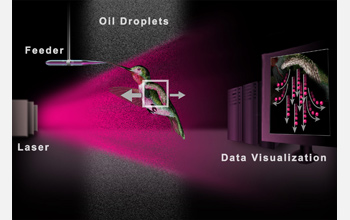Multimedia Gallery
Aerodynamics of Hummingbird Flight (Image 1)
Using a sophisticated digital imaging technique, scientists have now determined the aerodynamics of hummingbird flight. Researchers used digital particle imaging velocimetry (DPIV) to study the aerodynamics of hummingbird hovering. DPIV couples a digital camera that uses a laser light source with a computer, to track circulating microscopic oil droplets seeded in the air. The system allows scientists to follow the movement of individual particles when air is circulated by the bird's wings.
The team found that hummingbirds support 75 percent of their weight during the wing's down stroke and 25 percent on the up stroke--in contrast to insects, which produce equal amounts of lift during their down and up strokes. This data disproves conclusions from numerous earlier studies that hummingbirds hovered like insects despite their profound muscle and skeletal differences.
This image accompanied NSF press release, "Ultra-Fast Camera Captures How Hummingbirds Hover." [See related image Here.]
Credit: Nicolle Rager Fuller, National Science Foundation
Images and other media in the National Science Foundation Multimedia Gallery are available for use in print and electronic material by NSF employees, members of the media, university staff, teachers and the general public. All media in the gallery are intended for personal, educational and nonprofit/non-commercial use only.
Images credited to the National Science Foundation, a federal agency, are in the public domain. The images were created by employees of the United States Government as part of their official duties or prepared by contractors as "works for hire" for NSF. You may freely use NSF-credited images and, at your discretion, credit NSF with a "Courtesy: National Science Foundation" notation.
Additional information about general usage can be found in Conditions.
Also Available:
Download the high-resolution JPG version of the image. (305 KB)
Use your mouse to right-click (Mac users may need to Ctrl-click) the link above and choose the option that will save the file or target to your computer.

